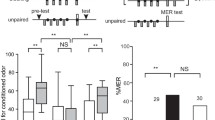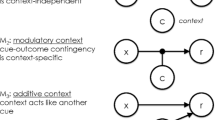Abstract
Classical conditioning is a basic form of associative learning in the animal kingdom. Many paradigmatic features of classical conditioning appear to be conserved throughout species and phyla and are independent of stimulus nature. This paper presents an analysis of trial-based and real-time models of classical conditioning which are mathematical abstractions of the underlying processing principles. Various models are reviewed and in a formal analysis, their capability of simulating and explaining classical conditioning is investigated. Since every existing model fails to simulate some particular conditioning phenomena and since some modelling approaches are not appropriate for detailed mathematical analysis, new model components will be introduced that overcome most of the weaknesses observed in the other models.
Similar content being viewed by others
References
Atkinson, R. C. and W. K. Estes (1963). Stimulus sampling theory, in Handbook of Mathematical Psychology, R. D. Luce, R. B. Bush and E. Galanter (Eds), Vol. 3, New York: Wiley, pp. 121–268.
Barto, A. G., R. S. Sutton and C. W. Anderson (1983). Neuronlike adaptive elements that can solve difficult learning control problems. IEEE Trans. Syst., Man Cybern. 13, 834–846.
Bitterman, M. E., R. Menzel, A. Fietz and S. Schäfer (1983). Classical conditioning of proboscis extension in honeybees (Apis mellifera). J. Comp. Psychol. 97, 107–119.
Byrne, J. H. and K. J. Gingrich (1989). Mathematical model of cellular and molecular processes contributing to associative and nonassociative learning in aplysia, in Neural Models of Placticity: Experimental and Theoretical Approaches, J. H. Byrne and W. O. Berry (Eds), London: Academic Press, Chap. 4, pp. 58–72.
Donegan, N. H., M. A. Gluck and R. F. Thompson (1989). Intergrating behavioural and biological models of classical conditioning, in Computational Models of Learning in Simple Neural Systems, Hawkins, R. D. and G. H. Bower, (Eds) (The Psychology of Learning and Motivation Vol. 23), New York: Academic Press, pp. 109–156.
Gelperin, A., J. J. Hopfield and D. W. Tank (1986). The logic of limax learning, in Model Neural Networks and Behavior, A. I. Selverston (Ed.), New York: Plenum Press, Chap. 13, pp. 237–261.
Grossberg, S. (1987). Competitive learning: from interactive activation to adaptive resonance. Cognit. Sci. 11, 23.
Hammer, M. and R. Menzel (1995). Learning and memory in the honeybee. J. Neurosci. 15, 1617–1630.
Hawkins, R. D. (1989). A simple circuit model for higher-order features of classical conditioning, in Neural models of plasticity, J. H. Byrne and W. O. Berry (Eds), Orlando: Academic Press, Chap. 5, pp. 73–92.
Hebb, D. O. (1949). The Organization of Behavior, New York: Wiley.
Hellstern, F., R. Malaka and M. Hammer (1997). Backward inhibitory learning in honeybees. Manuscript for Learning and Memory.
Hopfield, J. J. (1982). Neural networks and physical systems with emergent collective computational abilities. Proc. Natl Acad. Sci. USA 79, 2554.
Klein, J. (1993). Lernabhängiges Timing der konditionierten Reaktion bei der olfaktorischen Konditionierung der Honigbiene, Apis mellifera. Diplomarbeit, FU Berlin.
Klopf, A. H. (1989). Classical conditioning: phenomena predicted by a drive-reinforcement model of neural function, in Neural Models of Placticity: Experimental and Theoretical Approaches, J. H. Byrne and W. O. Berry (Eds), London: Academic Press, Chap. 6, pp. 94–103.
Klopf, A. H. and J. S. Morgan (1990). The role of time in natural intelligence: implications of classical and instrumental conditioning for neuronal and neural-network modeling, in Learning and Computational Neuroscience: Foundations and Adaptive Networks, A. Gabriel and J. Moore (Eds), Cambridge: MIT Press, Chap. 11, pp. 463–495.
Macintosh, N. J. (1974). The Psychology of Animal Learning. New York, Oxford: Oxford University Press.
Macintosh, N. J. (1983). Conditioning and Associative Learning. New York, Oxford: Oxford University Press.
Malaka, R. and M. Hammer (1996). Real-time models of classical conditioning, in Proceedings of the International Conference on Neural Networks (ICNN’96), Washington, Vol. 2, Piscataway, NJ: IEEE Press, pp. 768–773.
Malaka, R., R. Lange and M. Hammer (1995a). A comparative study of real-time models for classical conditioning. In Learning and Memory: Proceedings of the 23rd Göttingen Neurobiology Conference, Vol. 1, N. Elser and R. Menzel (Eds), New York: Thieme-Verlag, Stuttgart, p. 74.
Malaka, R., R. Lange and M. Hammer (1995b). A constant prediction model for classical conditioning, in Learning and Memory: Proceedings of the 23rd Göttingen Neurobiology Conference, Vol. 1, N. Elser and R. Menzel (Eds), New York: Thieme-Verlag, p. 75.
Menzel, R. (1990). Learning, memory and ‘cognition’ in honey bees, in Neurobiology of Comparative Cognition, R. P. Kesner and D. S. Olton (Eds), Hillsdale, NJ: Lawrence Erlbaum Ass. Publ.
Menzel, R., M. Hammer, G. Braun, J. Mauelshagen and M. Sugawa (1991). Neurobiology of learning and memory in honeybees, in The Behaviour and Physiology of Bees, L. J. Goodman and R. C. Fisher (Eds), Oxon, U.K.: CAB International, Chap. 22, pp. 323–353.
Montague, P. R. and T. J. Sejnowski (1994). The predictive brain: temporal coincidence and temporal order in synaptic learning mechanisms. Learning and Memory 1, 1–33.
Moore, J. W., N. E. Berthier and D. E. J. Blazis (1990). Classical eye-blink conditioning: brain systems and implementation of a computational model, in Learning and Computational Neuroscience: Foundations and Adaptive Networks, A. Gabriel and J. Moore (Eds), London: MIT Press, Chap. 8, pp. 359–387.
Moore, J. W. and D. E. J. Blazis (1989). Simulation of a classical conditioned response: a cerebellar neural network implementation of the Sutton-Barto-Desmond model, in Neural Models of Placticity: Experimental and Theoretical Approaches, J. H. Byrne and W. O. Berry (Eds), London: Academic Press, Chap. 11, pp. 187–207.
Pavlov, I. P. (1927). Conditioned Reflexes. London: Oxford University Press.
Pearce, J. M. (1987). A model for stimulus generalization in Pavlovian conditioning. Psychol. Rev. 94, 61–73.
Pearce, J. M. and G. Hall (1980). A model for Pavlovian learning: variations in the effectiveness of conditioned but not of unconditioned stimuli. Psychol. Rev. 87, 532–552.
Rescorla, R. A. (1977). Pavlovian second-order conditioning: some implications for instrumental behaviour, in Operant Pavlovian Interactions, H. Davis and H. M. B. Hurwitz (Eds), Hillsdale, NJ: Erlbaum.
Rescorla, R. A. (1988). Behavioral studies of Pavlovian conditioning. Ann. Rev. Neuroscience 11, 329–352.
Rescorla, R. A. and A. R. Wagner (1972). A theory of Pavlovian conditioning: variations in the effectiveness of reinforcement and non-reinforcement, in Classical conditioning: Current Theory and Research, Vol. 2, A. H. Black and W. F. Prokasy (Eds), Appleton-Century-Crofts, pp. 64–99.
Rumelhart, D. E., G. E. Hinton and R. J. Williams (1986). Learning internal represantations by error propagation, in Parallel Distributed Processing: Explorations in the Microstructures of Cocnition, Vol. 1, D. E. Rumelhart and J. L. McClelland (Eds), London: MIT Press, Chap. 8, pp. 318–362.
Sejnowski, T. J. and G. Tesauro (1989). The Hebb rule for synaptic plasticity: algorithms and implementations, in Neural Models of Placticity: Experimental and Theoretical Approaches, J. H. Byrne and W. O. Berry (Eds), London: Academic Press, Chap. 6, pp. 94–103.
Smith, B. H., C. I. Abramson and T. R. Tobin (1991). Conditional withholding of proboscis extension in honey bees (apis mellifera) during discriminative punishment. J. Comp. Psychol. 105, 345–356.
Sutton, R. S. and A. G. Barto (1981). Toward a modern theory of adaptive networks: expectation and prediction. Psychol. Rev. 88, 135–170.
Sutton, R. S. and A. G. Barto (1990). Time-derivative models of Pavlovian reinforcement, in Learning and Computational Neuroscience: Foundations and Adaptive Networks, A. Gabriel and J. Moore (Eds), London: MIT Press, Chap. 12, pp. 497–537.
Sutton, R. S., A. G. Barto and R. J. Williams (1991). Reinforcement learning is direct adaptive optimal control. to appear in Proceedings of the 1991 American Control Conference.
Tesauro, G. (1990). Neural models of classical conditioning: A theoretical viewpoint, in Connectionist Modelling and Brain Function: The Developing Interface, S. J. Hanson and C. R. Olson (Eds), London: MIT Press, Chap. 4, pp. 74–104.
Thompson, R. F. (1989). Neural circuit for classical conditioning of eyelid closure response, in Neural Models of Placticity: Experimental and Theoretical Approaches, J. H. Byrne and W. O. Berry (Eds), London: Academic Press, Chap. 9, pp. 160–177.
Wagner, A. R. (1981). SOP: A model of automatic memory processing in animal behaviour, in Information Processing in Animals: Memory Mechanisms, Vol. 85, N. E. Spear and R. R. Miller (Eds), Hillsdale, NJ: Erlbaum, Chap. 1, pp. 5–44.
Wagner, A. R. and N. H. Donegan (1989). Some relationships between a computational model (SOP) and a neural circuit for Pavlovian (rabbit eyeblink) conditioning, in Computational Models of Learning in Simple Neural Systems, (The Psychology of Learning and Motivation Vol. 23), R. D. Hawkins and G. H. Bower (Eds), London: Academic Press, pp. 157–203.
Wagner, A. R. and M. B. Larew (1985). Opponent processes and Pavlovian inhibition, in Information Processing in Animals: Conditioned Inhibition, R. R. Miller and N. E. Spear (Eds), Hillsdale, NJ: Erlbaum, pp. 233–265.
Wagner, A. R. and R. A. Rescorla (1972). Inhibition in Pavlovian conditioning: application of a theory, in Inhibition and Learning, R. A. Boakes and M. S. Halliday (Eds), London: Academic Press, pp. 301–336.
Widrow, G. and M. E. Hoff (1960). Adaptive switching circuits, in Western Electronic Show and Convention, Convention Record, Vol. 4, pp. 96–194.
Author information
Authors and Affiliations
Rights and permissions
About this article
Cite this article
Malaka, R. Models of classical conditioning. Bull. Math. Biol. 61, 33–83 (1999). https://doi.org/10.1006/bulm.1998.9998
Received:
Accepted:
Issue Date:
DOI: https://doi.org/10.1006/bulm.1998.9998




